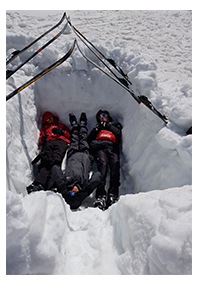At Melbourne Grammar School much of the study of Science occurs within the classroom but, on occasion, students are given the opportunity to further their learning in the outdoors, as we did on a recent cross-country ski tour, touring the trails around Falls Creek. Every day some time was allotted to ‘science hour’, and Mr Baylis and some of our other experienced guides shared the science of the environment in which we were skiing with us.
For instance, we learnt that the patterns imprinted on the bottom of our skis allowed us to grip the ice, particularly when skiing up hills.There was also a layer of wax on them, which melted the ice slightly as we skied down the hill, so that we could glide smoothly.
We also learnt about the albedo effect, where ice and other materials reflect sunlight, which cools the earth slightly as there is less energy (heat) being trapped by the atmosphere. However, due to climate change, there is less ice to reflect the heat and what ends up happening is the negative feedback cycle of global warming. It is information such as this, learnt while in the field, that shapes how we view our future.
Backcountry safety was a vital element of the camp. We learnt through first-hand examination that there are different layers of snow and ice.
When these layers slip they can create an avalanche. Furthermore, we learnt to identify avalanche high-risk hotspots using advanced technology such as an avalanche probe and tracker. We put a beacon inside a dry bag that was hidden by one group, dug into the snow, while another group had to find it by using a receiver for the beacon and then an avalanche probe. This game of hide and seek was related to a possible real ‘life or death’ situation.
One afternoon was spent building and testing a number of different shelter types, ideal for different conditions. This included a Quincy, which is built by making a mound of snow encircled by ice blocks and then dug out the inside with a structure that kept us both warm and ventilated. We also built a wind-shelter which is a hole in the ground that uses blocks cut out of the ground to create a windshield, making the process efficient and quick. The last shelter we made was a snow cave which was a hole dug into the side of a hill, that can be used in an emergency when on the slopes. This was so warm that many people sat inside for a while to get out of the cold.
This camp was a great opportunity for all members of the group to learn scientific skills, outside the School gates, which are relevant to our world today.
John Mordes and Felix Archibald Year 10 students
Related topics

